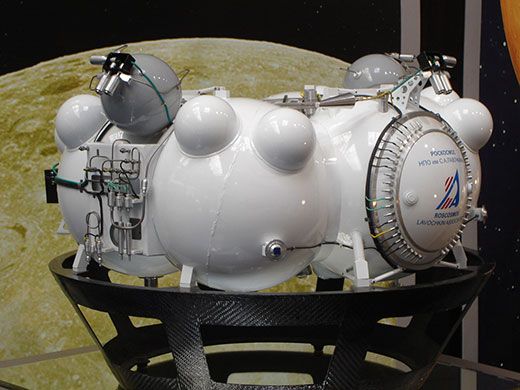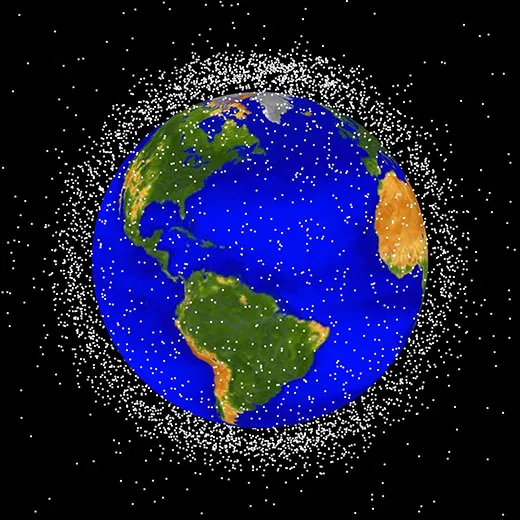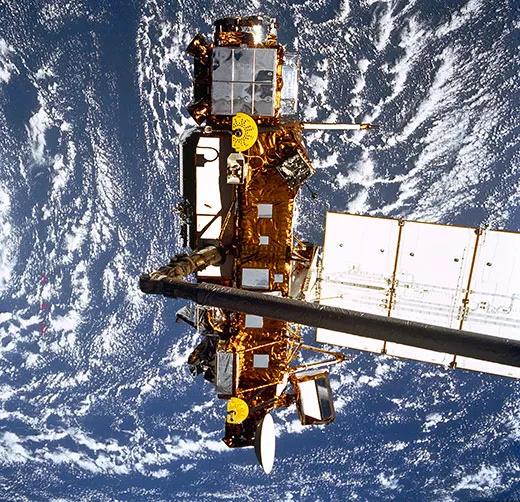Space Garbage: The Dark Cloud Above
A mass of debris from satellites and space missions is orbiting our planet—and it may be growing all the time
/https://tf-cmsv2-smithsonianmag-media.s3.amazonaws.com/filer/space-debris-low-Earth-orbit-631.jpg)
Earler this month, Russia’s failed space probe Phobos-Grunt crashed to earth, likely somewhere in the Pacific Ocean; despite long odds, millions of people around the planet worried that it would spell their doom. This past September, similar concerns surfaced about where the remnants from a falling NASA research satellite would land.
But the greater danger, experts say, isn’t the occasional stray object that re-enters the earth’s atmosphere. It’s the enormous cloud of nuts, bolts, shards of metal, satellite fragments and empty rocket thrusters that is floating invisibly above our planet. After decades of space exploration, there are now more than 500,000 pieces of artificial debris greater than half an inch in size—detritus that will continue to orbit for decades. This swarm of debris is a menace for spaceflight, communications satellites, and pretty much anything else we might want to do in space.
“It’s just like polluting a river or Lake Erie. If it’s polluted, you can’t use it,” says Paul Ceruzzi, a curator at the National Air and Space Museum. “There are lanes of orbits in space that are filling up with debris, and you really can’t use them. If you put up a satellite in that lane, you'll get hit by some of the debris, which will destroy the satellite. If a person is in spaceflight, they would get killed by it.”
The cloud of space debris evokes the enormous gyre of trash scientists have found in the center of the Pacific—far enough away to easily ignore, yet a looming reminder of humankind’s inability to control its impacts on the environment. And, like the oceanic garbage patch, the mass of space junk began accumulating before anyone even suspected its existence.
It began in the earliest days of the space age, says Nicholas L. Johnson, chief scientist at NASA’s Orbital Debris Program. Contrary to popular belief, only a tiny fraction of the space trash has originated with astronauts simply leaving tools or other items to float off into space. “Back in the ’60s and ’70s, when operators were done with their vehicles, be they spacecraft or rocket bodies, they would typically leave propellant on board,” he says. “That propellant was the primary source of later explosions.” As spacecraft exploded—due to increasing pressure over time or the accidental mixing of propellant and oxidizer, the two main components of rocket fuel—they sent vast amount of tiny fragments careening off into orbit.
Although NASA identified the problem in the early 1980s and was able to successfully convince the international space community to “passivate”—remove all residual fuel from a spacecraft after finishing with it—two recent events have contributed greatly to the space debris problem. “The first event was the Chinese anti-satellite test in January of 2007,” says Johnson. “That was a deliberate action—the Chinese sent a device to impact an old weather satellite at very high speed.” The other event, in 2009, was an accidental collision between a U.S.-owned communications satellite and a derelict Russian satellite. The two incidents combined created some 5,000 pieces of cataloged debris (objects larger than four inches)—nearly a third of the total in orbit.
The Department of Defense calculates daily the individual orbits for the roughly 16,000 cataloged pieces of debris, while Johnson’s office uses telescopes, radar and statistical programs to track smaller objects. The majority of the pieces are in low-earth orbit, within 1,200 miles of earth. The amount of time a single piece of debris stays in orbit depends on its altitude, among other factors: lower-orbiting items pick up more drag from the atmosphere and descend more quickly, within the span of months or years. Higher-altitude objects can remain in orbit for decades or even centuries.
NASA has led the way in establishing international rules that require safe retrieval plans for all satellites launched, but the debris already in orbit poses an ongoing problem, says Greg Allen, a senior analyst at Avascent, an aerospace consulting group. “The thing is that you can have a small accident—such as a piece of debris hitting a satellite—that could cause a massive problem,” he says. “If you think about anything tiny hitting you, like a wrench, in low-earth-orbit space it’s hitting you at 17,000 miles per hour. That’s like an extremely powerful missile hitting you, just from the kinetic energy alone.” Last July, the crew of the International Space Station was forced to take shelter in evacuation pods when a piece of debris passed perilously close—within 1,100 feet of the station at 29,000 miles per hour.
The NASA Orbital Debris Program works to minimize potential accidents by anticipating them. “We do an assessment for every operational satellite, looking typically three days into the future, and if we think that some other object is going to come close to hitting it, we notify the owner-operator,” Johnson says. “Then it’s up to the owner-operator to do something.” On average, he says, there is one collision-avoidance maneuver per week.
The bigger issue, though, is what will happen to defunct satellites and other large objects that can’t be moved. “Only about 5 percent of these large objects are operational spacecraft. The other 95 percent are uncontrollable,” says Johnson.
These constant collisions produce ever more pieces of debris, which then lead to even more collisions. As a result, the number of orbiting objects might actually continue to increase even if we stop producing debris entirely. In 1978, NASA scientist Donald J. Kessler postulated that if the density of objects in low-earth orbit hit a tipping point, it would trigger such a chain reaction. This phenomenon is now known as the Kessler syndrome, and a report released by the National Academy of Sciences in September indicates that we may well have already passed the point of no return for space junk.
This has prompted some to consider a drastic step: actively cleaning up earth’s orbit. A range of plans—from the practical to the seemingly harebrained—have been proposed to accomplish this feat. “There’s the classic technique, where you simply have a vehicle, it goes up, it rendezvous with a derelict object and it latches onto it,” says Johnson. “Once you've captured it, you bring it down to a lower altitude or all the way into the earth's atmosphere.” This approach would likely be prohibitively costly, though, so more innovative schemes abound. Suggestions include ground-based lasers, unmanned orbiting clean-up vehicles, mesh nets suspended by inflatable space booms, adhesive gels and even “sails” that could be attached to pieces of debris and increase their drag enough to bring them down.
These plans are presently the stuff of science fiction—the technologies are nowhere near advanced enough to capture tiny pieces of junk moving at 17,000 miles per hour or more. With so much at stake, though, it’s imperative that scientists find a solution. “Some really valuable orbits—like maybe a weather satellite orbit, or a spy satellite orbit—could just be off limits because they’re so congested,” Allen says. “Space is incredibly valuable, so we really don't want to lose it.”
/https://tf-cmsv2-smithsonianmag-media.s3.amazonaws.com/accounts/headshot/joseph-stromberg-240.jpg)



/https://tf-cmsv2-smithsonianmag-media.s3.amazonaws.com/accounts/headshot/joseph-stromberg-240.jpg)